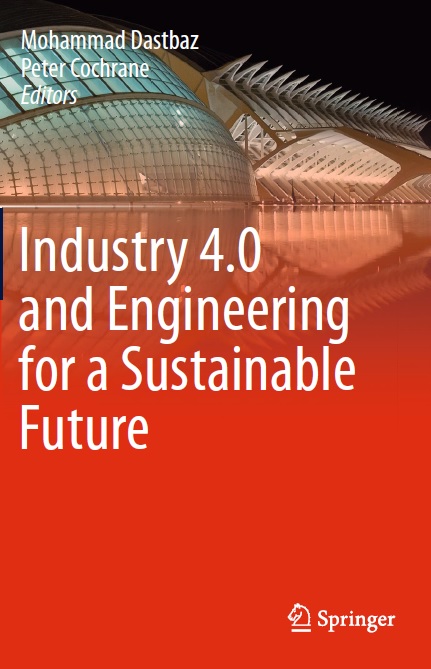By Mohammad Dastbaz and Peter Cochrane

Contents
1 Industry 4.0 (i4.0): The Hype, the Reality, and the Challenges Ahead 1
Mohammad Dastbaz
2 Why Industry 4.0? 13
Peter Cochrane
3 Connectivity for Industry 4.0 23
Kristina Gold, Kenneth Wallstedt, Jari Vikberg, and Joachim Sachs
4 Wireless Comms. Beyond 2020 49
William Webb
5 Digital Transformation 65
Paul Graham
6 Big Data, Small Data, and Getting Products Right First Time 77
Human Ramezani and Andre Luckow
7 The Internet of Things and Sustainable Manufacturing 91
David Heatley and Mohamed Abdel-Maguid
8 Security Challenges in the Industry 4.0 Era 117
Mohammed M. Alani and Mohamed Alloghani
9 Meeting the Future Challenges in Cyber Security 137
Ben Azvine and Andy Jones
10 Ready for Industry 4.0? The Case of Central
and Eastern Europe 153
Wim Naudé, Aleksander Surdej, and Martin Cameron
11 From Big to Small Data 177
Peter Cochrane and Ahmed Elmagarmid
12 The Role of Blockchain in Underpinning Mission Critical
Infrastructure 191
Hamid Jahankhani and Stefan Kendzierskyj
13 The Planning and Design of Buildings:
Urban Heat Islands—Mitigation 211
Christopher Gorse, James Parker, Felix Thomas, Martin Fletcher,
Graham Ferrier, and Neill Ryan
Index 227
Industry 4.0 (i4.0): The Hype, the Reality, and the Challenges Ahead
Mohammad Dastbaz
Introduction
In the aftermath of the 2008 global financial crises, a debate around how to recover from the crises and ensure future growth, as well as the role of technology in the future of this growth, is pursued. In a report titled “Industrie 4.0” (Industry 4.0), the German government through its “Ministry of Education and Research” and the “Ministry for Economic Affairs and Energy” proposed a national strategic initiative focused on building a digital society and pushing digital manufacturing into an ever-expanding interconnection of products, value chains and business models (European Commission Report 2017).
While the report generated a lot of interest and it was followed by the German government initiating ten “Future Projects”, the reality is that 7 years later and despite numerous debate and position papers both from industry and academia, the full concept and potential of Industry 4.0 remain largely poorly understood and not widely implemented or exploited.
In a report published by Deloitte on “Industry 4: Are you ready”, in January 2018, Punit Renjen, its global CEO, writes: “… Wristwatches monitoring vital signs to warn of impending heart attacks. Factories running at optimal capacity, with every process monitored and adjusted in real time. With the emergence of big data, cloud computing, the Internet of Things, 3D printing, and more, this is the world being ushered in by the fourth industrial revolution (Industry 4.0)” (Deloitte Review 2018).
The report highlights the fact that only 14% of CXOs are confident that their organisations are ready to fully harness and benefit from what i4.0 has to offer. Before attempting to provide a framework of what i4.0 in its current stage of development is, what are the key areas of technology that define i4.0 and how we can move beyond the jargons and the hype, it will be useful to provide a historical context to i.4.0 and its predecessors and how they impacted our development over the past 250 years.
Historical Context
The extant literature indicates that the Industrial Revolution started in the 1760s in Britain. With the emergence of steam engine and steam power at the dawn of the first Industrial Revolution (and from now on i.1.0), a significant shift in the mode of production from cottage industry production to large-scale mechanisation took place. The dawn of the Industrial Revolution and the shift from framing/cottage-based production to large-scale factories also signalled the beginning of an era of significant scientific discoveries and innovation (Dastbaz et al. 2016).
From “the spinning jenny” that increased wool mills productivity in 1764 to James Watt’s first reliable steam engine in 1775, the “telegraph communications” in the early 1800, and finally Joseph Aspdin who, in 1824, devised and patented a chemical process for making “Portland cement”, the world rapidly changed, in both producing manufactured goods to how we rapidly developed population centres (town and cities). According to Eric McLamb (2011), following the Industrial Revolution in the late 1700s, the world’s population grew by 57% to 700 million and then quickly reached the billion mark by 1800, and within the first 100 years of the Industrial Revolution, it grew by a further 600 million to reach 1.6 billion (MacLam 2011) (Fig. 1.1). Key Technical Advances: High-Frequency Transistors, IC, and ARPANET
Looking at the how our current technological advances have been affected, one could identify a number of key technical advances that all happened within a span of two decades following the end of the World War II. According to historic documents, the transistor was invented by three American physicists, John Bardeen, Walter H. Brattain and William B. Shockley, at the American Telephone and Telegraph Company’s Bell Laboratories in 1947–1948 (Development of Transistors n.d). The transistor’s high reliability and low consumption as compared to the electron tube, as well as its capacity to compress complex circuitry into a small device, made significant changes to the development of modern electronics (Fig. 1.2).
Following the invention of the transistor, it was the emergence of integrated circuit (IC), first successfully tested in September 1958, by Jack Kilby, that paved the way for the emergence of the modern computing.
In his patent application on 6 February 1959, Kilby described his new device as “a body of semiconductor material … wherein all the components of the electronic circuit are completely integrated”(Winston 1998).
